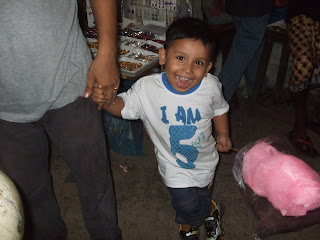For those not familiar with Islamic rites, let me try to clarify. The beginning of an Islamic month depends on the first sighting of the new moon, therefore, any month, including the month of Ramadan, can have either 29 or 30 days. We don’t know until the evening of 29th Ramadan whther or not Eid will be the next day or if we will have to fast another day. The term Chaand Raat refers to the evening on which the new moon is sighted. City streets wear a festive look, and brightly decorated markets remain open late into the night. I would compare this with Cristmas Eve, but more festive because of the elements of uncertainty and anticipation.
Once the moon is sighted, people say a quick dua (brief prayer), thanking Allah for allowing us to complete the month of fasting and to celebrate Eid. We wish each other Eid Mubarak (Blessings of Eid Day). In more peaceful (I should say less stressful) times, young children lit firecrackers. Of course, with the ever escalating urban crime-rate, authorities have banned such things. I know it's a good thing, but logic unfortunately loses the fight with nostalgia.
The famous song by national poet Kazi Nazrul Islam starts resonating around the country “Ramjan-er oi rojar sheshey elo khushir Eid”. A rough translation would be ‘Happy Eid has come after the fasting of Ramadan’. It's a happy, catchy tune, and instantly lifts spirits. Although the words of the song are sombre, yet we can all identify with the fervent passion that induced the lyrics. I think that this song has become an integral part of our culture by transcending the narrow boundaries of religion. Listen to the song at http://www.youtube.com/watch?v=VQMUYERFeqc
My friend and colleague Afroja happily consented to escort me around town. My husband, unfortunately, had chickened out. How like a … husband!!?? Anyway, we ventured out around 9pm and returned home well past the bewitching hour. We had a wonderful time!

People rush to the markets to do a last round of shopping, and markets stay open very late, until 2 am or so. These photos were taken at midnight on Chaand Raat, believe it or not.




Flowers brighten up a house like nothing else. And the flower market near Dhaka University was doing a brisk trade even at such a later hour.




We bought locally-grown orchids, paying a third of the price my Gulshan florist had asked for. I thought rather uncharitable thoughts about rip-off businessmen who view Ramadan as the money-making time of the year... and ethics be damned (pardon the language!).

Kitchens are busy with the preparation of various sweet dishes. We make Zarda (a saffron scented rice dish), Shemai and Firni or Kheer (thickened and sweetened milk with a few grains of rice) are traditional Eid items. Oh the calories...the calories!!! The blogging girl had decided to prepare her specialty Carrot Halwa (so what that it’s not traditional Eid food?), Shemai and Mitha Tukda (fried bread pieces soaked in thickened and sweetened milk). But she had finished her Eid cooking well before Iftar - so as to have the evening free for viewing Chaand Raat activities around town. Smart, eh?

Women of all ages decorate their hands with mehendi (henna).

And the final mad rush begins for those heading out of town to celebrate Eid with families. Bus and steamer/launch terminals and trains stations are packed, and even with standing room only, tickets are sold at exorbitant prices.

(Photo courtesy: The New Age)
I'll be back tomorrow with Eid photos. Meanwhile, you can visit the BBC website for a picture story on Eid-Al-Fitr in different countries around the world.
Also check out http://www.boston.com/bigpicture/2008/09/observing_ramadan.html
No comments:
Post a Comment